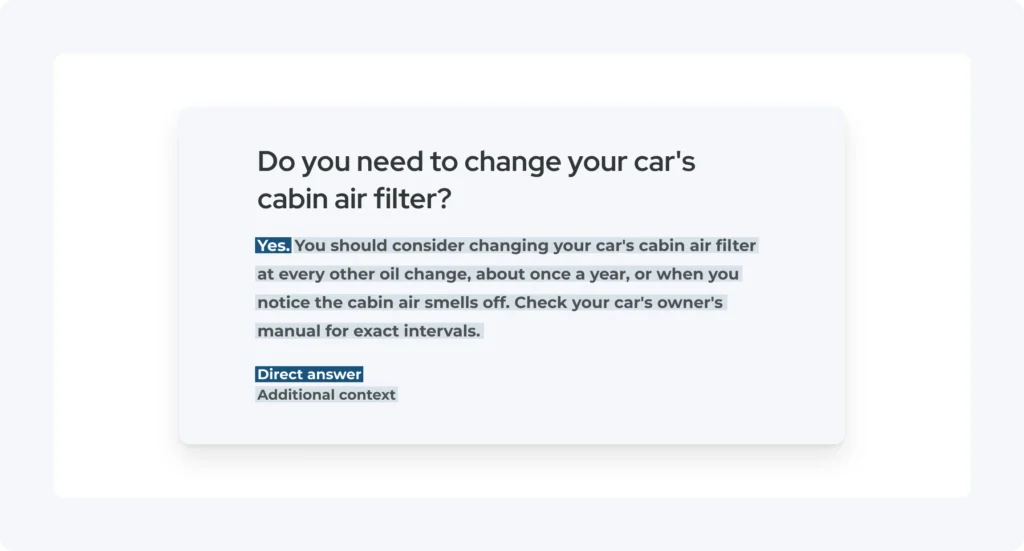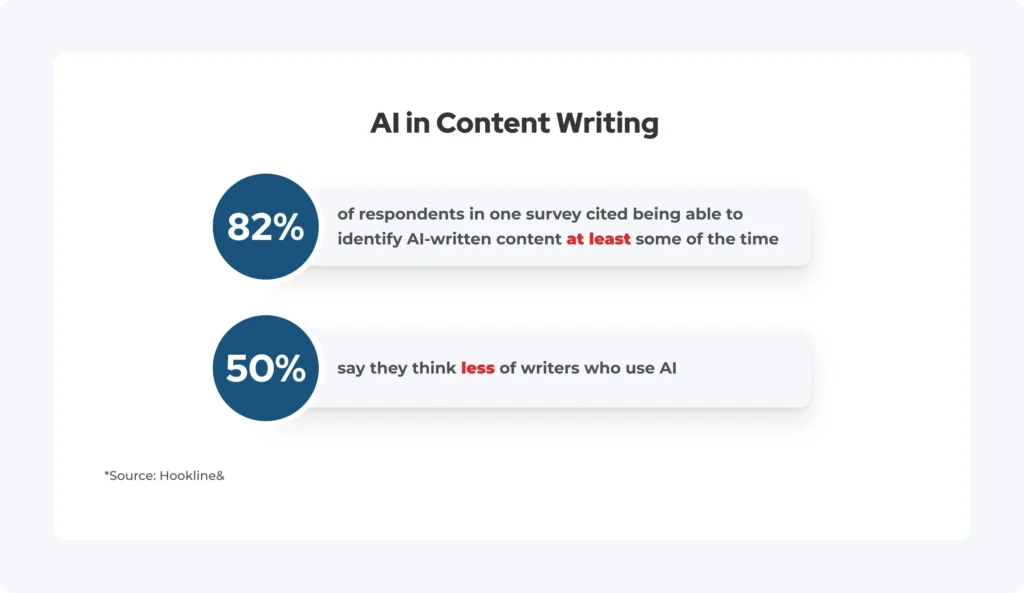Key Takeaways
- Search engine pages are consistently changing, leading writers to need to adjust their content to ensure the greatest possible chances of ranking.
- Content marketers can optimize their content by knowing their audience, maintaining strategic keyword usage, and making content digestible for human readers.
- Some crucial ways to optimize content in 2025 include adjusting for AI overviews and ensuring content prioritizes friendliness to the reader.
- Content marketers should avoid relying on AI-generated content and strive to ensure their content sounds natural with a focus on the reader.
A Guide To Writing SEO Content in 2025
Content marketing is changing considerably as SEO content writers must adapt to search engine updates and pervasive new technologies. A few times a year, Google makes significant changes to its search algorithms with core updates. These core updates keep content marketers on their toes, having to adapt so that they can continue to optimize content for search engines. Google already released a new core update in March 2025, just 3 months after the previous one in December 2024.
The growth of artificial intelligence (AI) and its increase in use on SERPS in the form of AI overviews also poses a new challenge to SEO content creators. However, one thing hasn’t changed—search engines will continue to prioritize content that provides the most value to readers.
With frequent updates and search engines embracing AI, content marketers must be strategic in their writing so that they can provide readers with the greatest possible value. This guide highlights key content marketing tips for 2025 that can empower you to focus on adapting to both search engines and human readers while helping you create content that converts.

The 7 Key Content Marketing Tips for Writers
By being proactive and strategic, SEO content writers can overcome the latest challenges to create content that ranks well in search engines and converts into sales. Writers can optimize their content by following these content writing tips.
1. Know Your Audience
Your ultimate goal is to make written content as useful as possible for your readers, so knowing your audience is paramount. It’s crucial that you understand the intent of their search so that your content speaks to the information they are actually interested in reading.
For example, looking at the search queries can tell you the intent of the person searching:
- Informational keywords will include questions from people looking for broad information, often starting with “What,” “When,” or “How”.
- Transactional keywords will include action terms focused on taking action, like “Sign up” or “Buy”.
- Navigational keywords include terms focused on reaching specific pages, often naming precise places or brands.
- Commercial keywords are those for people interested in educating themselves about specific products or services before purchase, often using terms that involve comparisons, like “Best” or “vs.”
Including too much information that your readers aren’t interested in can lead to a loss of engagement and ultimately make your content less effective. Doing your best to know exactly what they’re looking for will help you stay ahead of this.
Beyond understanding search intent, it’s also helpful to understand your audience’s demographics and psychographics, like typical age group, interests, location, and goals. This context will inform how you write, what type of language you use, and the flow of your content.
2. Demonstrate Authority
The authoritativeness of the site where content is displayed is a key ranking factor and is a crucial consideration for creating optimized content. Google heavily values EEAT, which stands for Experience, Expertise, Authority, and Trustworthiness. One of the best ways to do this is to designate an author for each piece and have an author page with their credentials on the site. This approach signals to Google that the person writing the content has credibility to be talking about it and can provide value to the reader.
However, it’s important to demonstrate EEAT in your content through a variety of methods:
- Including factual information and statistics in your content
- Linking to sources with authority, like .gov or .org sites
- Adding internal links to other areas of your site to demonstrate your expertise in multiple fields of the subject matter
Ideally, you should take all of the above steps in coordination with each other to supplement the strength of each piece of content.
3. Get to the Point and Answer the Question
As you write, be direct and answer the key questions in each heading specifically.
If you can answer questions succinctly in content, you are more likely to capture the featured snippets or AI overviews at the top of the SERP. Besides, your target audience likely doesn’t want to filter through a ton of unnecessary information and extra paragraphs they don’t really need.
Best practice is to use the key question as a heading and then answer that question concisely in the first sentence following it. If additional context is helpful, then you can add that in the subsequent sentences. Answering questions concisely will both increase the chances of AI overviews spotlighting your content, while also keeping readers from clicking away from your content.
For example, if your heading is “Do you need to change your car’s cabin air filter?”
Your first sentence should be “Yes”. Then you can move on to explaining additional context around this answer in the following sentences.

Although AI overviews present their challenges by potentially driving traffic away from the websites below them, they can be yet another tool for getting your content seen by your target audience. Catering to these search tools may also benefit your content and site, as these sites choosing your content may signal a strong site authority.
4. Use Your Keywords Strategically
Just as they have always been, keywords are still an integral part of an effective content strategy, and the value of conducting keyword research cannot be overstated. Still, it’s important that you use them strategically and not recklessly.
Consider some of these best practices for keywords:
- Avoid stuffing keywords into your text – Trying too hard to repeat a target keyword into your content will come across as spam, and instead, keywords should fit naturally into the flow of your content while prioritizing the information.
- Use primary keywords in your intro and headings – Placing keywords in your H2s and H3s signals that your content focuses heavily on the topic being searched for and might be of value to the reader searching.
- Include semantic keywords – These keywords are also important for demonstrating the usefulness of your content to search engines, but here, too, remember not to be too heavy-handed and to avoid keyword stuffing.
Ultimately, keywords are still valuable, but writers should prioritize the flow of their content for ease of reading over including as many keywords as possible. Unique content that balances discussing a targeted keyword in context while being easy to read is most likely to rank.
5. Make Your Content Digestible
If your readers click on your content and are confronted with a huge wall of text, it’s going to be difficult for them to stay engaged. Writers need to be able to mix it up and keep content digestible and easy for the eye to follow in order to keep readers engaged and help them find their answers more quickly—this usually means including visual elements and avoiding long chains of text.
Ensuring your content is digestible is more important for SEO than one might initially think. Digestible content is more likely to keep your readers on page longer and lead them to continue clicking through your site, which boosts your credibility with search engines.
Ways to make your content more digestible include:
- Use headings and subheadings to break up content
- Include bulleted lists to share information (like this one)
- Incorporate visual graphics
- Bold key information throughout the article
- Use simple and clear language for readability
- Keep paragraphs short and to the point (usually about two sentences or under 75 words)
Using these tips will make your content easier to read and browse through. By engaging readers, your work will also be more likely to help you reach your goals of driving sales.
6. Act Natural
As you write your content, don’t just try to check all the SEO boxes by stuffing in keywords—those days are gone. Recent core updates are more likely to reward content that reads naturally and is written to be as reader-friendly as possible.
Maybe a few years ago, you could get away with stuffing in your keywords sentence after sentence to game the system. Today, however, it just comes across as spammy. Instead, your focus should be solely on ensuring that your content delivers the information your readers are looking for and presents said information in a conversational and easy-to-read manner.
Focus on creating content designed for humans first, and then sprinkle in your primary keywords and internal links tastefully to jump off this foundation. Create your content with the goal of covering the point and answering your reader’s questions as directly as possible to ensure it’s meaningful.
7. Stay Human
Many marketers have attempted to leverage AI to pump out written content as quickly as possible. However, as quickly as marketers started to swing towards AI, many started to swing back, as human-written content still maintains the advantage.
Many readers can still detect AI-written content, making the content potentially come across as less natural and trustworthy. As much as 82% of respondents in one survey cited being able to identify AI-written content at least some of the time, with 50% of respondents saying they think less of writers who use AI.
Search engines may also be penalizing AI-written content compared to human-written content. Google has also recently directed its quality raters to assess whether the main content in a webpage and rate it as lowest quality in its January 2025 update of Search Quality Rater Guidelines.

All told, if you’re weighing whether it’s worth using AI-generated content, we’d recommend steering clear of it. That said, AI can still be a valuable tool—however, it is better served for generating ideas and acting as an assistant than generating finished written content. It’s all about finding a balance, but that balance should keep human writers at the foundation of your content marketing strategy.
Optimize Your Content with collystring
Ultimately, writing optimized content in 2025 means being able to create quality yet concise content that speaks to your audience’s needs. The above content marketing tips can help, but if you’re looking to refine your content strategy, having an expert team by your side can make all the difference.
At collystring, our Content team of writers puts all of the above strategies into practice to create the best possible content, working closely with our expert SEO strategists. As a one-stop shop boutique agency, we’ll work to understand your brand voice, goals, and target audience to create optimized content that resonates with your consumers.
Contact us today to schedule a discovery call and discuss how we can boost your content strategy.
